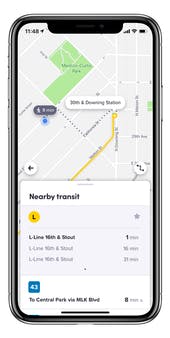Lyft's "Nearby Transit" feature to be rolled out in Denver
Lyft says the feature allows users to identify the transportation option that best fits their trip and budget and furthers the company's commitment to offering transit solutions that enhance mobility
“Lyft is committed to providing holistic transportation options that offer sustainable solutions and help reduce congestion on Denver’s roads,” said Gabe Cohen, general manager of Lyft Rockies Region. “This is another step toward creating a more seamless and connected transportation network and helping build a stronger community by working in partnership with RTD.”
According to Lyft’s 2019 Economic Impact Report, 46 percent of riders nationwide take public transit at least once a week, and 23 percent of riders in Denver use Lyft to get around where public transit does not operate, such as when their starting point or destination isn’t directly along the transit route, and Lyft can get them to the first or last mile. The report also found 53 percent of vehicle owners in Colorado reported using their cars less because of Lyft. Reducing single-occupancy vehicles is a shared goal between RTD and Lyft.
“We believe that cities deserve more efficient and reliable transportation options,” said Cohen. “Through Nearby Transit, Lyft is affirming our dedication to a multimodal future.”
This is the second shared mobility partnership RTD has forged in recent months. In February, RTD and Uber launched in-app transit integration, which allows users to see and consider transit options within the Uber app and will eventually support RTD ticket purchases.
RTD notes that it is uniquely positioned to lead the dialogue around the Denver metro region’s mobility strategy as it actively pursues relationships that integrate new mobility services with traditional public transportation.
“The collaboration we are announcing today with Lyft offers the public additional, complementary first-mile and last-mile options,” said RTD General Manager and CEO Dave Genova. “In addition, it extends our reach -- providing Lyft users with an understanding of the transit options available to them as they plan how to get around.”
Denver is the seventh city where Lyft has rolled out Nearby Transit. It is also available in Boston, Chicago, Los Angeles, Santa Monica, Seattle and Washington, D.C. Denver Mayor Michael Hancock adds that the Nearby Transit feature brings a balance to the area's mobility options.
“Equity is a value that we’re applying to everything we do, including mobility, and first-mile, last-mile gaps often stand in the way of our residents and neighborhoods being able to choose transit as a reliable mobility option," Mayor Hancock said. "Nearby Transit is one more tool we can deploy to fill those service gaps and make that easy connection to transit options available for our residents."
About the Author

Mischa Wanek-Libman
Group Editorial Director
Mischa Wanek-Libman is director of communications with Transdev North America. She has more than 20 years of experience working in the transportation industry covering construction projects, engineering challenges, transit and rail operations and best practices.
Wanek-Libman has held top editorial positions at freight rail and public transportation business-to-business publications including as editor-in-chief and editorial director of Mass Transit from 2018-2024. She has been recognized for editorial excellence through her individual work, as well as for collaborative content.
She is an active member of the American Public Transportation Association's Marketing and Communications Committee and served 14 years as a Board Observer on the National Railroad Construction and Maintenance Association (NRC) Board of Directors.
She is a graduate of Drake University in Des Moines, Iowa, where she earned a Bachelor of Arts degree in Journalism and Mass Communication.
